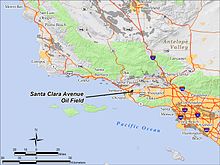Santa Clara Avenue Oil Field
| Santa Clara Avenue Oil Field | |
|---|---|

The Santa Clara Avenue Oil Field in Ventura County, California.
|
|
| Country | United States |
| Region | Ventura Basin |
| Location | Ventura County, California |
| Offshore/onshore | onshore |
| Operators | Venoco, Inc. |
| Field history | |
| Discovery | 1972 |
| Start of development | 1972 |
| Start of production | 1972 |
| Peak year | 1977 |
| Production | |
| Current production of oil | 211 barrels per day (~10,500 t/a) |
| Year of current production of oil | 2009 |
| Estimated oil in place | 1.335 million barrels (~1.821×105 t) |
| Producing formations | Sespe Formation |
The Santa Clara Avenue Oil Field is an oil field in Ventura County, California, about six miles southeast of the city of Ventura and four miles northeast of Oxnard. It is produced entirely from two walled drilling islands along Santa Clara Avenue, each containing multiple directionally drilled wells. The field is within an agricultural area being encroached on several sides by urban development. As of 2010 the field reported 1,335,000 barrels of recoverable oil remaining, and had 18 active oil wells. Denver-based Venoco, Inc. was the sole operator on the field.
The field is within the Oxnard Plain, a rich agricultural region subject to encroachment from urban development from the cities of Oxnard, Ventura, and Camarillo. Oil production and storage equipment are surrounded by agricultural fields and orchards. Crops grown nearby include onions, broccoli, and strawberries. U.S. Highway 101 runs along the south edge of the oil field, and Santa Clara Avenue runs through it from southwest to northeast, ending at California State Route 118. The unincorporated town of El Rio is west of the field, and the unincorporated development of Nyeland Acres lies to the south, adjoining Oxnard. The total surface area of the productive part of the field is 180 acres (73 ha).
The climate in the region is Mediterranean, with cool, rainy winters and warm, rainless summers, during which the heat is moderated by frequent morning coastal low clouds and fog. Annual precipitation is around 15 inches (380 mm), almost all in the winter, and all in the form of rain. The mean annual temperature is 56 to 60 °F (13 to 16 °C); freezes occur rarely. The field is mostly flat, with the elevation averaging 80-foot above sea level (24 m). Drainage is south to Calleguas Creek to Mugu Lagoon, and then to the Pacific Ocean.
The Oxnard field is within the Ventura Basin Province of southern California. Geologically, this area is part of a structural downwarp that occurred during the late Pliocene. Deposition within the basin occurred fast enough to fill it with up to seven kilometers of sedimentary rock in only five million years. While most of the rocks filling the basin are marine sediments, some igneous rocks from the Conejo Volcanics series overlie them. Oil accumulations, which are common in the Ventura Basin, mainly occur in anticlinal settings modified by faulting. Stratigraphy is also influential in creating traps for hydrocarbons. Where the sedimentary rocks are sandstones with high porosity, and the structure and stratigraphy allow hydrocarbons to be trapped on their upward migration, oilfields are found. In the Santa Clara Avenue field, oil is trapped in numerous thin layers of oil sands within the Sespe Formation, of Oligocene age. Oil is trapped updip where it encounters the impermeable Conejo Volcanics. This igneous unit was originally thought to be a canyon fill, but more recently has been interpreted to be a quickly cooling, finely crystalline intrusion.
...
Wikipedia
